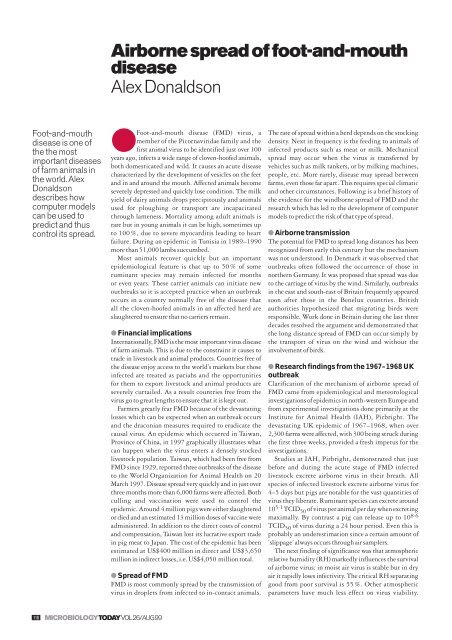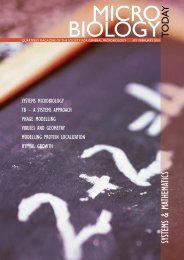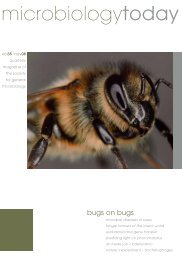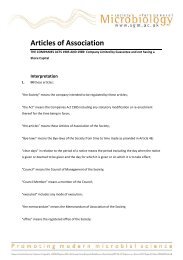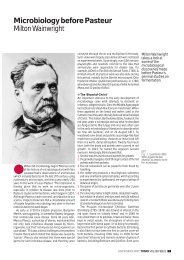Airborne spread of foot-and-mouth disease Alex Donaldson
Airborne spread of foot-and-mouth disease Alex Donaldson
Airborne spread of foot-and-mouth disease Alex Donaldson
Create successful ePaper yourself
Turn your PDF publications into a flip-book with our unique Google optimized e-Paper software.
Foot-<strong>and</strong>-<strong>mouth</strong><br />
<strong>disease</strong> is one <strong>of</strong><br />
the the most<br />
important <strong>disease</strong>s<br />
<strong>of</strong> farm animals in<br />
the world. <strong>Alex</strong><br />
<strong>Donaldson</strong><br />
describes how<br />
computer models<br />
can be used to<br />
predict <strong>and</strong> thus<br />
control its <strong>spread</strong>.<br />
118<br />
MICROBIOLOGYTODAY VOL 26/AUG 99<br />
<strong>Airborne</strong> <strong>spread</strong> <strong>of</strong> <strong>foot</strong>-<strong>and</strong>-<strong>mouth</strong><br />
<strong>disease</strong><br />
<strong>Alex</strong> <strong>Donaldson</strong><br />
●Foot-<strong>and</strong>-<strong>mouth</strong> <strong>disease</strong> (FMD) virus, a<br />
member <strong>of</strong> the Picornaviridae family <strong>and</strong> the<br />
first animal virus to be identified just over 100<br />
years ago, infects a wide range <strong>of</strong> cloven-ho<strong>of</strong>ed animals,<br />
both domesticated <strong>and</strong> wild. It causes an acute <strong>disease</strong><br />
characterized by the development <strong>of</strong> vesicles on the feet<br />
<strong>and</strong> in <strong>and</strong> around the <strong>mouth</strong>. Affected animals become<br />
severely depressed <strong>and</strong> quickly lose condition. The milk<br />
yield <strong>of</strong> dairy animals drops precipitously <strong>and</strong> animals<br />
used for ploughing or transport are incapacitated<br />
through lameness. Mortality among adult animals is<br />
rare but in young animals it can be high, sometimes up<br />
to 100%, due to severe myocarditis leading to heart<br />
failure. During an epidemic in Tunisia in 1989–1990<br />
more than 51,000 lambs succumbed.<br />
Most animals recover quickly but an important<br />
epidemiological feature is that up to 50% <strong>of</strong> some<br />
ruminant species may remain infected for months<br />
or even years. These carrier animals can initiate new<br />
outbreaks so it is accepted practice when an outbreak<br />
occurs in a country normally free <strong>of</strong> the <strong>disease</strong> that<br />
all the cloven-ho<strong>of</strong>ed animals in an affected herd are<br />
slaughtered to ensure that no carriers remain.<br />
● Financial implications<br />
Internationally, FMD is the most important virus <strong>disease</strong><br />
<strong>of</strong> farm animals. This is due to the constraint it causes to<br />
trade in livestock <strong>and</strong> animal products. Countries free <strong>of</strong><br />
the <strong>disease</strong> enjoy access to the world’s markets but those<br />
infected are treated as pariahs <strong>and</strong> the opportunities<br />
for them to export livestock <strong>and</strong> animal products are<br />
severely curtailed. As a result countries free from the<br />
virus go to great lengths to ensure that it is kept out.<br />
Farmers greatly fear FMD because <strong>of</strong> the devastating<br />
losses which can be expected when an outbreak occurs<br />
<strong>and</strong> the draconian measures required to eradicate the<br />
causal virus. An epidemic which occurred in Taiwan,<br />
Province <strong>of</strong> China, in 1997 graphically illustrates what<br />
can happen when the virus enters a densely stocked<br />
livestock population. Taiwan, which had been free from<br />
FMD since 1929, reported three outbreaks <strong>of</strong> the <strong>disease</strong><br />
to the World Organization for Animal Health on 20<br />
March 1997. Disease <strong>spread</strong> very quickly <strong>and</strong> in just over<br />
three months more than 6,000 farms were affected. Both<br />
culling <strong>and</strong> vaccination were used to control the<br />
epidemic. Around 4 million pigs were either slaughtered<br />
or died <strong>and</strong> an estimated 13 million doses <strong>of</strong> vaccine were<br />
administered. In addition to the direct costs <strong>of</strong> control<br />
<strong>and</strong> compensation, Taiwan lost its lucrative export trade<br />
in pig meat to Japan. The cost <strong>of</strong> the epidemic has been<br />
estimated at US$400 million in direct <strong>and</strong> US$3,650<br />
million in indirect losses, i.e. US$4,050 million total.<br />
● Spread <strong>of</strong> FMD<br />
FMD is most commonly <strong>spread</strong> by the transmission <strong>of</strong><br />
virus in droplets from infected to in-contact animals.<br />
The rate <strong>of</strong> <strong>spread</strong> within a herd depends on the stocking<br />
density. Next in frequency is the feeding to animals <strong>of</strong><br />
infected products such as meat or milk. Mechanical<br />
<strong>spread</strong> may occur when the virus is transferred by<br />
vehicles such as milk tankers, or by milking machines,<br />
people, etc. More rarely, <strong>disease</strong> may <strong>spread</strong> between<br />
farms, even those far apart. This requires special climatic<br />
<strong>and</strong> other circumstances. Following is a brief history <strong>of</strong><br />
the evidence for the windborne <strong>spread</strong> <strong>of</strong> FMD <strong>and</strong> the<br />
research which has led to the development <strong>of</strong> computer<br />
models to predict the risk <strong>of</strong> that type <strong>of</strong> <strong>spread</strong>.<br />
● <strong>Airborne</strong> transmission<br />
The potential for FMD to <strong>spread</strong> long distances has been<br />
recognized from early this century but the mechanism<br />
was not understood. In Denmark it was observed that<br />
outbreaks <strong>of</strong>ten followed the occurrence <strong>of</strong> those in<br />
northern Germany. It was proposed that <strong>spread</strong> was due<br />
to the carriage <strong>of</strong> virus by the wind. Similarly, outbreaks<br />
in the east <strong>and</strong> south-east <strong>of</strong> Britain frequently appeared<br />
soon after those in the Benelux countries. British<br />
authorities hypothesized that migrating birds were<br />
responsible. Work done in Britain during the last three<br />
decades resolved the argument <strong>and</strong> demonstrated that<br />
the long distance <strong>spread</strong> <strong>of</strong> FMD can occur simply by<br />
the transport <strong>of</strong> virus on the wind <strong>and</strong> without the<br />
involvement <strong>of</strong> birds.<br />
● Research findings from the 1967–1968 UK<br />
outbreak<br />
Clarification <strong>of</strong> the mechanism <strong>of</strong> airborne <strong>spread</strong> <strong>of</strong><br />
FMD came from epidemiological <strong>and</strong> meteorological<br />
investigations <strong>of</strong> epidemics in north-western Europe <strong>and</strong><br />
from experimental investigations done primarily at the<br />
Institute for Animal Health (IAH), Pirbright. The<br />
devastating UK epidemic <strong>of</strong> 1967–1968, when over<br />
2,300 farms were affected, with 300 being struck during<br />
the first three weeks, provided a fresh impetus for the<br />
investigations.<br />
Studies at IAH, Pirbright, demonstrated that just<br />
before <strong>and</strong> during the acute stage <strong>of</strong> FMD infected<br />
livestock excrete airborne virus in their breath. All<br />
species <strong>of</strong> infected livestock excrete airborne virus for<br />
4–5 days but pigs are notable for the vast quantities <strong>of</strong><br />
virus they liberate. Ruminant species can excrete around<br />
10 5.1 TCID50 <strong>of</strong> virus per animal per day when excreting<br />
maximally. By contrast a pig can release up to 10 8.6<br />
TCID 50 <strong>of</strong> virus during a 24 hour period. Even this is<br />
probably an underestimation since a certain amount <strong>of</strong><br />
‘slippage’ always occurs through air samplers.<br />
The next finding <strong>of</strong> significance was that atmospheric<br />
relative humidity (RH) markedly influences the survival<br />
<strong>of</strong> airborne virus: in moist air virus is stable but in dry<br />
air it rapidly loses infectivity. The critical RH separating<br />
good from poor survival is 55%. Other atmospheric<br />
parameters have much less effect on virus viability.
For example, sunlight causes little or no loss <strong>of</strong> virus<br />
infectivity in aerosols. Any effect <strong>of</strong> sunlight is probably<br />
indirect <strong>and</strong> through the generation <strong>of</strong> air currents which<br />
reduce the concentration <strong>of</strong> virus by physical dilution.<br />
● Computer-based models<br />
Through collaboration between IAH, Pirbright, <strong>and</strong> the<br />
UK Meteorological Office, a computer-based model was<br />
developed during the 1970s for assessing the risk <strong>of</strong><br />
airborne <strong>spread</strong> <strong>of</strong> FMD. It was created by bringing<br />
together data on the aerobiology <strong>of</strong> FMD with data on<br />
the physical behaviour <strong>of</strong> particles in the atmosphere<br />
under different climatic conditions. The model was<br />
shown to be capable <strong>of</strong> giving a prediction within a few <strong>of</strong><br />
hours <strong>of</strong> the confirmation <strong>of</strong> an outbreak <strong>of</strong> FMD <strong>of</strong><br />
whether there was a risk <strong>of</strong> <strong>spread</strong> <strong>and</strong>, if so, which farms<br />
were in jeopardy. The model could predict accurately up<br />
to a distance <strong>of</strong> 10 km from the source. Any farms<br />
considered to be at risk could be placed under intensive<br />
surveillance so that suspected cases could be quickly<br />
identified <strong>and</strong> eliminated. The model was used<br />
successfully under operational conditions during the<br />
outbreaks <strong>of</strong> FMD on Jersey <strong>and</strong> the Isle <strong>of</strong> Wight in<br />
March 1981.<br />
Work continued to refine <strong>and</strong> improve the model. The<br />
next experimental objective was to determine the doses<br />
<strong>of</strong> airborne virus which can infect different species.<br />
Using natural aerosols <strong>of</strong> FMD virus produced by<br />
infected pigs the minimum doses capable <strong>of</strong> initiating<br />
infection were found to be remarkably low. Doses as<br />
low as 10 1.0 <strong>and</strong> 10 1.3 TCID50 could infect a sheep<br />
<strong>and</strong> a steer, respectively. The minimum dose <strong>of</strong> natural<br />
aerosol to infect a pig has not been determined but some<br />
observations suggest that it is probably much higher<br />
than that for other species.<br />
These experimental results, namely the high output<br />
<strong>of</strong> airborne virus by pigs <strong>and</strong> the extreme sensitivity<br />
<strong>of</strong> cattle to respiratory infection, provide an explanation<br />
for the findings <strong>of</strong> field studies where the pattern <strong>of</strong><br />
<strong>spread</strong> <strong>of</strong> FMD over long<br />
distances has invariably<br />
been from infected pigs at<br />
source to cattle downwind.<br />
The availability <strong>of</strong> a<br />
model called ‘Rimpuff’,<br />
developed at the Riso<br />
National Laboratory,<br />
Denmark, to simulate<br />
the <strong>spread</strong> <strong>of</strong> airborne<br />
radioactive particles <strong>and</strong><br />
gases such as might<br />
occur following a nuclear<br />
accident, created the<br />
opportunity to improve<br />
the airborne prediction<br />
model for FMD. In a<br />
collaboration between IAH, Pirbright, <strong>and</strong> the Danish<br />
Meteorological Institute a virus production model<br />
(VPM) was developed <strong>and</strong> linked to Rimpuff. The<br />
VPM–Rimpuff system was validated using data from<br />
epidemics <strong>of</strong> FMD in France <strong>and</strong> the UK in 1981 as<br />
well as from the former East Germany <strong>and</strong> Denmark in<br />
1982. A good fit was obtained between the <strong>spread</strong><br />
predicted by the model <strong>and</strong> that which actually took<br />
place (Fig. 1).<br />
The VPM-Rimpuff system is much more<br />
sophisticated than the earlier prediction model in that<br />
both short-range <strong>and</strong> meso-scale (up to 300 km)<br />
transmission can be modelled. It is also much faster,<br />
it can simulate simultaneous emission from several<br />
sources, as may occur during actual epidemics, <strong>and</strong> can<br />
be linked to geographical information systems <strong>and</strong><br />
numerical weather prediction models.<br />
In the event <strong>of</strong> an outbreak <strong>of</strong> FMD it would now be<br />
feasible for a veterinary service to operate the model <strong>and</strong>,<br />
if a risk <strong>of</strong> airborne <strong>spread</strong> was indicated, to deploy its<br />
manpower accordingly. It should then be in a good<br />
position to respond to any suspected cases at the earliest<br />
opportunity <strong>and</strong> prevent further <strong>spread</strong> <strong>of</strong> <strong>disease</strong>.<br />
● Dr <strong>Alex</strong> <strong>Donaldson</strong> is Head <strong>of</strong> the Pirbright<br />
Laboratory <strong>of</strong> the Institute for Animal Health,<br />
Woking, Surrey GU24 ONF<br />
Tel. 01483 232441; Fax 01483 232448<br />
e-mail alex.donaldson@bbsrc.ac.uk<br />
LEFT:<br />
Fig. 1. Location <strong>of</strong> outbreaks <strong>of</strong><br />
FMD in France <strong>and</strong> the UK during<br />
March 1981 <strong>and</strong> the plume <strong>of</strong><br />
airborne FMD virus from pig<br />
farms in Brittany simulated by<br />
the VPM–Rimpuff prediction<br />
model for the 24 hours before<br />
midnight on 8 March 1981.<br />
COURTESY STEVEN ARCHIBALD,<br />
IAH, PIRBRIGHT<br />
MICROBIOLOGYTODAY VOL 26/AUG 99 119


